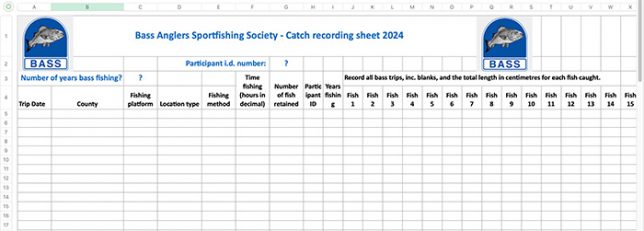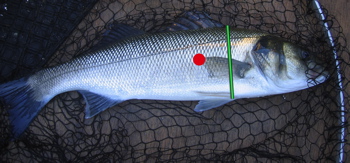Aims and objectives
The aims of the catch recording system are to obtain regional indicators of fishing quality (good or bad), and show how this may vary over the seasons and the years. This will provide valuable data that can be shared within BASS, and with researcher partners and fisheries managers.
A linked objective is to obtain information about which year classes are featuring in catches, both from the analysis of fish lengths, and by participants taking scales from occasional fish which are representative of each size group they are catching. The ageing of fish from scales also facilitates the study of bass growth, and scales may also be used other types of research.
Process
Any BASS member may participate in the scheme. Although involvement from the beginning of the season is best, participants may join at any point in the year. Participants may usefully include trips prior to receipt of the catch recording sheet on a retrospective basis where this is possible.
Participating anglers are asked to complete a catch return, recording every trip (including blanks) they make where they are targeting bass. This will be done by using a spreadsheet provided (incorporating instructions for completion). For those anglers who do not have access to Excel, a printed sheet can be sent by post.
Details required for each trip will be;
- date
- County
- fishing platform (shore or boat)
- location type (open coast, estuary or estuary mouth)
- fishing method (lure, bait or fly)
- trip duration (time spent fishing)
- number of fish retained
- lengths of all fish caught (if applicable)
If a scale has been sent for aging, the date sent/age of fish etc. can be added to the length entry for the relevant fish using a note or comment; likewise, any weights the participant may wish to supply. There are drop down boxes for County, Fishing Platform, Location Type and Fishing Method. Entries in these fields can be copied if required.

It is appreciated that measuring the length of every fish may be time-consuming where multiple fish are involved. It is important that we have the best measurement possible for all fish, regardless of size. However, where a number of fish of the same length are being caught, it is acceptable to measure the first three or four and estimate the length of the remainder. This estimate must give a specific length, and not a size range.
Where measurement is difficult, for example when wading far from shore, it is acceptable to use, for example, your rod butt marked with tape at 5cm intervals to measure the fish. Results can be noted in pocket-sized notebooks, such as the ‘Rite in the rain’ waterproof notebook, or other convenient medium, before transferring to the spreadsheet later.
Participants should email their completed spreadsheet to the organiser at the end of their fishing season, and no later than mid-January. A graphical summary of their own results, and a copy of the full report of the scheme, will be sent to all participants.
Participants will record an id number on the spreadsheet (name not required). This number will be assigned to each participant by the scheme organisers. This will not be divulged to others.
Analysis and results
Examples of statistics produced:
- number of fish caught per trip/hour
- fish length and frequency of capture
- % of productive trips
- % of fish over 60cm
- hours to catch fish over 60cm
The results will be used in BASS publications. Where individual anglers’ stats are shown, these will be under id number.
Scales
Scales should be sent to the BASS scale reader (see inside front page of BASS mag for address), who may be contacted for information and scale packets. Advice from the BASS Scale Sampling Guide includes:
Remove scales from the area around the point of the pectoral fin (see picture – red dot) by using tweezers or fingernails and pulling away firmly. Take 3 scales from each side of the fish if conditions allow; if not, take 6 from one side – not all together but from various points within the correct area; If you are going to keep the fish, then do take more, say 10in total.

Scale replacement is common and occurs when the fish has lost scales though abrasion or predator attack for example. The fish is able to completely replace the scale within a year of its loss (MAFF Fisheries Research Technical Report No. 103).
Robin Bradley, Danny Bowering and Patrick Ashton – scheme organisers On behalf of the BASS Science Group (1.2.24).
For more information, or to register an interest, email sciencegroup@ukbass.com If you would like to receive a complimentary BASS tape, please let us know at the time of registration.
Please note that the catch recording system is separate from, and does not affect the submission of ad-hoc catch reports to the BASS Catch Recorders.